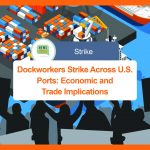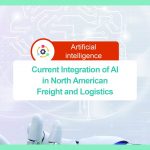Infrastructure Projects of Mexico’s New President, Claudia Sheinbaum: Highlights for Ground Freight Transportation
The new Mexico’s president, Claudia Sheinbaum, has outlined a series of infrastructure projects aimed at boosting the country’s connectivity and economic growth. Her agenda includes the continuation of key rail projects such as the Maya Train, the Interoceanic Train, and the Mexico-San Luis Potosí-Nuevo Laredo Passenger Train, focused on both passenger and freight transportation. These projects are part of a strategy to improve national mobility and logistics integration, supporting the interconnection between different regions and production hubs.
However, within this strategy, the development of road infrastructure is also a priority, an essential component for freight transportation. The goal is to improve the existing road network and create new economic opportunities, enhancing competitiveness and facilitating logistics across various industrial sectors.
The document “100 Steps for Transformation” outlines some of the actions aimed at modernizing the country’s roads and, in particular, supporting ground freight transportation, which is crucial for the supply chain in various sectors. This article focuses on the aspects that directly impact road transport and freight logistics, which will be key to capitalizing on the global trend of nearshoring and strengthening Mexico’s logistics in the North American supply chain.

Infrastructure and Key Enablers for Regional Development in Sheinbaum’s Administration
In Sheinbaum’s vision, regional development is one of the pillars for achieving balanced economic growth. To support this growth, a series of key enablers are considered, including:
- Logistic infrastructure such as highways, roads, ports, and airports.
- Telecommunications infrastructure.
- Supply of basic services (water, electricity, natural gas).
- Environmental regulations focused on sustainable development.
- Development and integration of professionals and technicians to ensure a specialized workforce that supports the growth of strategic sectors.
The development of road infrastructure aligns with the nearshoring strategy, aimed at attracting international investment to Mexico and strengthening regional production chains, while reducing reliance on imports from Asia.
Relocalization and Nearshoring: An Opportunity for Mexico
The phenomenon of nearshoring, which involves bringing production chains closer to end consumer markets, presents an unprecedented opportunity for Mexico. With the instability of global supply chains, many companies are opting to relocate their production to North America, and Mexico is in a privileged position to take advantage of this shift. Factors such as macroeconomic stability, a broad network of trade agreements, existing logistics infrastructure, and a young, specialized workforce make Mexico an attractive destination for investors.
Under the Fourth Transformation, the economic relationship with the United States and Canada has reached historic levels in trade and investment. In 2022, Mexican exports to the T-MEC trading partners totaled $488.17 billion, a 31% increase compared to 2018. Investments from both countries in Mexico also grew by 48% during the same period. As a result, Mexico has displaced China as the United States’ primary trading partner.
Foreign direct investment from these countries has also significantly increased, with strong integration of supply chains in key sectors such as automotive, electrical, and electronics.
In this context, the road infrastructure projects in Sheinbaum’s plan aim to ensure that Mexico can meet the growing demand for freight transportation, facilitating both exports and regional production within the framework of the T-MEC.
Regional development and the definition of those latent economic activities, whose existence in a certain region is not openly manifested, but which has the potential to be developed extensively in the near future, by state, will enable continuity of the focus on developing value chains in priority sectors for North America.
The Main Sectors of Sheinbaum’s Industrial Policy
The main sectors of industrial policy that will be promoted in the new administration are:
- Semiconductors
- Electronics
- Electromobility
- Medical devices
- Agroindustry
The 10 Industrial Corridors
The strategy includes the creation of 10 specialized industrial corridors aimed at improving road infrastructure and generating logistical opportunities that directly impact freight transportation. These corridors, which cover various regions of the country, are designed to promote local production and export to international markets, such as the United States and Canada. The corridors are as follows:
- Transístmico (Oaxaca, Veracruz, Tabasco, and Chiapas): Renewable energy, specialized manufacturing, agroindustry, and logistics.
- AIFA (Mexico City, State of Mexico, Hidalgo): Medical devices, chemical-pharmaceuticals, logistics, specialized manufacturing, and food and beverages.
- Gulf (Veracruz, Tabasco, Chiapas, and Campeche): Petrochemicals, hydrocarbons, timber, fruits, and fishing.
- Pacific (Nayarit, Jalisco, Colima, and Michoacán): Agroindustry, Industry 4.0, logistics, and tourism.
- Northern Border (Chihuahua, Coahuila, Nuevo León, and Tamaulipas): Auto parts, manufacturing, and agroindustry.
- Baja California (Baja California, Baja California Sur, Sonora, and Sinaloa): Semiconductors, renewable energy, tourism, and agriculture.
- Bajío (Querétaro, Guanajuato, San Luis Potosí, and Aguascalientes): Automotive, data centers, aerospace, and tourism.
- Maya (Yucatán, Chiapas, Tabasco, Campeche, and Quintana Roo): Tourism, agroindustry, renewable energy, food and beverages, and services.
- Central (Guerrero, Morelos, Puebla, and Tlaxcala): Textiles, automotive, and electrical-electronics.
- Northwest (Sonora, Sinaloa, Durango, and Zacatecas): Mining, agriculture, and electricity generation.
Development of Road Infrastructure
The road infrastructure plan includes the construction, expansion, and renovation of significant sections of the federal road network. These projects are crucial for improving freight mobility and facilitating interconnection between production hubs and consumer markets, both national and international.
Road Projects
Sheinbaum’s plan also encompasses several modernization and construction projects in strategic areas of the country, aimed at enhancing connectivity between key industrial and consumer centers. Among the most important projects are:
- The modernization of the Mexico-Querétaro highway, one of the busiest routes in the country, vital for trade between northern and central Mexico.
- The expansion of the Monterrey-Nuevo Laredo highway, essential for freight transportation to the United States, as it serves as one of the most important export routes.
- The development of new routes in the southeastern region of the country to support the Isthmus of Tehuantepec Corridor, a strategic project to promote interoceanic trade and reduce dependence on the Panama Canal.
- The creation of access roads and improvements in road maintenance in areas of agricultural and industrial production, facilitating the movement of products to ports and borders.
In addition to the projects focused on freight transportation by road, Sheinbaum’s infrastructure plan also includes significant developments in areas related to transportation and logistics. These include:
- Rail Projects: The continuation of important works such as the Maya Train, the Interoceanic Train, and the Mexico-San Luis Potosí-Nuevo Laredo Passenger Train, aimed at improving intermodal connectivity and promoting tourism and freight transport in strategic regions.
- Port Modernization: The expansion and modernization of key ports like Veracruz and Manzanillo, which will be essential for strengthening maritime trade and reducing bottlenecks in the movement of goods in and out of the country.
- Airport Development: Plans include enhancing airport infrastructure in various regions of the country, with the modernization of key airports to facilitate air connectivity, particularly for international cargo.










